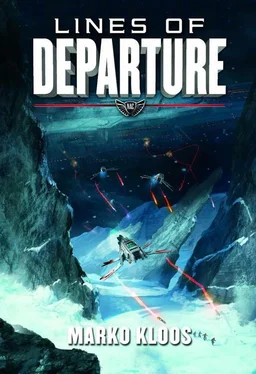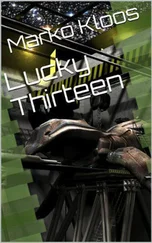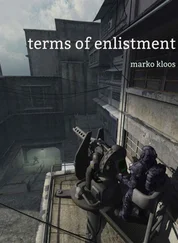“What about you, LT?”
“This’ll be number sixty-nine.”
“You counting the training drops, too?” I tease.
“Well, we can’t all be in demand like you, Grayson.”
“Be glad you’re not. I haven’t had any real leave since Combat Controller School. Would have been nice to trade some of those drops for some time off. I haven’t seen my mom in person since I shipped out for Basic.”
“You’re not missing much,” Lieutenant Graff says. “Next leave you get, make it a colony, or one of the rec centers. Earth ain’t much to look at these days.”
“You been Earthside recently? Where you from, anyway?”
“Houston metroplex. I went home on leave three months ago. It’s a fucking war zone now. You?”
“PRC Boston-Seven,” I say. “It was a war zone already when I left.”
“Kind of wrong, isn’t it? We bust our asses to keep Earth safe, and they shoot at us when we show up down there in uniform. Makes you wonder what we’re fighting for.”
I don’t have to wonder. I fight because the only alternative is to suck down recycled shit for food in a welfare city on Earth somewhere, and wait for the inevitable day when the Lankies conclude their interstellar pest control campaign against us by hopping into Earth’s orbit and nerve-gassing our filthy little ant hive of a planet.
I fight because it’s the only way I have to control my destiny at least a little bit.
———
It takes about thirty minutes to suit up in a Hostile Environment Battle Armor suit.
The HEBA suits are new hardware, relatively speaking. They were designed for offensive missions on Lanky worlds, and they’re so stuffed with state-of-the-art tech that regular old battle armor looks like a medieval suit of dented plate in comparison. The regular battle armor works on Lanky worlds, too, but their built-in oxygen tanks are too small, and their filtration systems get overwhelmed by the amount of biological contaminants in the air. The Lankies seed some sort of pollen into the atmosphere to kick-start their own version of agriculture, and a normal suit’s filters clog up in just a few hours.
The new HEBA suits have custom-tailored filters and a new oxygen storage system that lets a grunt carry enough breathable air for a few days of heavy physical activity. The armor is less resistant to small-arms fire than the standard infantry armor, but more flexible, and only half as heavy. The sensor package built into the helmet is advanced enough to navigate a starship: infrared, thermal imaging, millimeter-wave radar, ultrasound.
There’s a built-in trauma kit, and a superfast tactical computer to tie all the information streams together. Whoever designed the armor figured out that the visor is the weak spot in a helmet, and that keeping one from fogging up on a high-CO2 world is an unnecessary energy expense, so the new helmets don’t have visors. The lack of visible eyes, combined with the little bumps for the helmet’s sensor arrays, gives the wearer an insectoid appearance, so it took about five seconds after they released the first HEBA suits into the corps before someone coined the obvious nickname: bug suits .
The bug suits are custom-fitted to each wearer, and hideously expensive. The defense budget being what it is, they’re strictly limited issue. Only personnel with frequent business on Lanky worlds get one—recon, combat control, drop-ship pilots, and Spaceborne Rescue specialists. All in all, there are maybe three thousand troops in the entire corps who have a fitted bug suit. They’re strictly off-limits for missions against the SRA, because Command doesn’t want the tech to fall into Russian or Chinese hands.
I have a sort of love-hate relationship with my bug suit. It’s very comfortable, and the wealth of sensor input projected onto the inside of the helmet makes me feel almost omniscient. On the other hand, putting one on means I’m about to head out into Lanky country.
———
“Suits all check out,” the lieutenant announces. “We are ready for business. Weapons check, please.”
We all aim our rifles at the diagnostics target on the bulkhead and let the computers do the talking over the wireless network. Everyone’s carrying the new M-80 rifles, which are also specialized gear for use against Lankies. The old M-66 fléchette rifles are still in service, but only used against the Sino-Russians. The little tungsten needles fired from the M-66s don’t do much against the tough-skinned Lankies, so the new rifles fire twenty-five-millimeter dual-purpose rounds, a super-dense uranium penetrator piggy-backing on an explosive payload. The velocities needed for the penetrator to punch through a Lanky’s hide means a lot of caseless propellant, which in turn means monstrous recoil. It also means that the new rifles are vertically stacked twin barrels without magazines, because the recoil impulse is so strong that a multi-shot action would be impractically big and heavy. With only two rounds in the gun, the new rifles are damn near useless against the SRA, but they work quite well against the Lankies.
“All right,” the lieutenant says when we have finished the final weapons check. “Let’s go mess us up some Big Uglies.”
———
The recon team is four troopers strong: Lieutenant Graff, Staff Sergeant Humphrey, Sergeant Keller, and Corporal Lavoie. I’m the fifth wheel on this particular wagon, but nobody minds having me around, because I carry the radios that call down the thunder if there’s a need for it. We all drop in individual pods, to make sure the entire team isn’t wiped out if the launch crew miscalculates our ingress timing and shoots a pod right into the path of a Lanky proximity mine. The artillery people are good—the chance for a catastrophic pod-to-mine interface at ingress is only 1 percent—but two hundred missions mean rolling that particular set of dice two hundred times.
I strap into my bio-pod, which looks like an artillery shell carved out of rock. The mines don’t trigger for small, spaceborne inert objects such as asteroids, so our pods are designed to be a fair imitation of one. So far, they’ve worked as designed, but I worry before every launch that this particular one will be the drop where the Lankies have figured out how our recon teams get dirtside, and that my pod will be the first one to be blotted out of its trajectory by a newly updated mine.
“Final comms check,” the lieutenant says over the team channel. “Sound off, people. Give me a go/no-go.”
I listen to the team responding to the lieutenant’s challenge and add my own acknowledgment when everyone else is finished.
“Echo Five, copy and go for launch.”
“Echo One, copy we are go for launch. Comms go dark after this transmission until we are down in the dirt. I’ll see everyone on the ground in thirty. Echo One out.”
I give the launch tech standing next to my pod the thumbs-up sign. He returns the gesture and closes the lid of my pod. Immediately, my helmet’s low-light vision kicks in to compensate for the sudden darkness. There’s nothing to see in here except for the smooth inner surface of the pod’s lid, so I manually turn off the visual feed to conserve battery power.
The pod is loaded into the launch tube by an automatic feeder mechanism. At this point, I’m just like any other space-to-ground ordnance in the carrier’s magazines, except for the fact that I’m a biological weapon rather than a chemical or nuclear one. Ten of the Intrepid ’s 144 launch tubes have been converted for bio-pod launches, so an entire squad can be launched at the same time. For the next twenty-odd minutes, my life will be entirely in the hands of the ship’s automated systems—the ballistic computer that calculates the proper trajectory for my pod to weave through the Lanky minefield and get to the target zone, and the launch mechanism that will fire my pod out of the tube at just the right velocity. One computer glitch, one power surge or bump at the wrong moment, one misplaced decimal point in a programming subroutine, and I’ll end up shooting past the planet into deep space, or finely dispersed in a cloud of organic matter in the upper layers of the planet’s atmosphere.
Читать дальше












